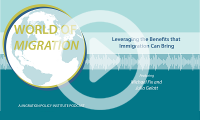Skills
Recent Activity
Marking the launch of MPI’s Global Skills and Talent Initiative, this webcast features senior policymakers and other experts discussing the extent to which labor market needs should shape future immigration policy decisions, and how countries are adjusting—and could adjust—their immigration systems to meet human capital and competitiveness needs.

Held immediately after the European Union unveiled its skills and talent package, this MPI Europe webinar explores how Europe can address its labor market needs at a time of great upheaval, and the role that immigration and immigrant integration policy can play in helping propel Europe’s economic recovery.

Experts on this webinar examined the scope and reality of skills shortages and the role of immigrants in the U.S. labor market, ways to address the underemployment of highly skilled immigrants, and how immigrants and immigration policy can be used to fulfil needs in the education sector, STEM occupations, and other skills needs.

In this World of Migration podcast episode, MPI Senior Fellow Michael Fix speaks with Senior Policy Analyst Julia Gelatt about the fiscal impacts of immigration, the importance of immigrant integration, how a greater focus on credential recognition could allow immigrants to more fully utilize the academic and professional skills they bring with them, and much more.

During this webcast, experts discuss findings from a report examining at U.S. and state levels the underemployment of college graduates by nativity and by race and ethnicity, in the process revealing patterns of economic inequality.
Pages
Recent Activity
The COVID-19 pandemic’s impacts on mobility in the Middle East and North Africa were immediate and wide-reaching. These include the world’s largest and most sustained repatriation efforts for stranded migrants, halted and reversed irregular journeys, and a reckoning with some countries’ reliance on foreign labor. This report examines how these impacts varied across countries in this highly diverse region, as well as the uneven recovery.
El desplazamiento de venezolanos ha llevado a países de toda América Latina y el Caribe a poner en marcha políticas y programas para registrar, regularizar y apoyar la integración de los venezolanos. Sin embargo, la medida en que la regularización ha ayudado a los venezolanos a encontrar trabajo ha variado de un país a otro, como se analiza en este informe.





















Investing in the Future: Higher Ed Should Give Greater Focus to Growing Immigrant-Origin Student Population